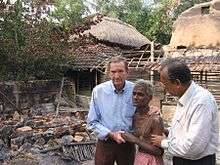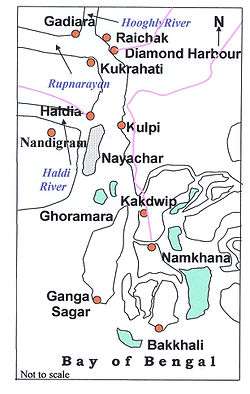Nandigram
| Nandigram নন্দীগ্রাম | |
|---|---|
| Census Town | |
 Nandigram  Nandigram Location in West Bengal, India | |
| Coordinates: 22°01′N 87°59′E / 22.01°N 87.99°ECoordinates: 22°01′N 87°59′E / 22.01°N 87.99°E | |
| Country |
|
| State | West Bengal |
| District | Purba Medinipur |
| Elevation | 6 m (20 ft) |
| Population (2011) | |
| • Total | 5,803 |
| Languages | |
| • Official | Bengali, English |
| Time zone | IST (UTC+5:30) |
| Lok Sabha constituency | Tamluk |
| Vidhan Sabha constituency | Nandigram |
| Website |
purbamedinipur |
Nandigram is a Census Town in Nandigram I CD Block in Haldia subdivision of Purba Medinipur district of the Indian state of West Bengal. It is located about 70 km south-west of Kolkata, on the south bank of the Haldi River, opposite the industrial city of Haldia. The area falls under the Haldia Development Authority.[1]
In 2007 the West Bengal government decided to allow Salim Group to set up a chemical hub at Nandigram under the special economic zone policy.[2] This led to resistance by the villagers resulting in clashes with the police that left 14 villagers dead, and accusations of police brutality.
Firoza Bibi of All India Trinamool Congress is the newly elected Member of Legislative Assembly from Nandigram Assembly Constituency, by-elections for which were held on 5 January 2009.[3]
Demographics
As per 2011 Census of India Nandigram had a total population of 5,803 of which 2,947 (51%) were males and 2,856 (49%) were females. Population below 6 years was 725. The total number of literates in Nandigram was 4,512 (88.85% of the population over 6 years).[4]
Police station
Nandigram police station has jurisdiction over Nandigram I and Nandigram II CD Blocks. Nandigram police station covers an area of 251.25 km2 with a population of 279,285.[5][6]
People of Nandigram

Although this part of Bengal has not been actively highlighted in Indian History during British period, the area had been a part of active politics from the British era. With the help of the people of Nandigram, "Tamluk" was freed from the British by Ajoy Mukherjee, Sushil Kumar Dhara, Satish Chandra Samanta and their friends for a few days (which is the only part of modern India to be freed twice), before India gained de facto freedom in 1947.
In post Independent India, Nandigram had been a centre of learning and played a major part in the development of Haldia, a satellite town of Calcutta (Kolkata). Fresh vegetables, Rice and fish are being supplied to Haldia from Nandigram. Like Haldia, Nandigram has a natural strategic geographic location for business and farming. The Ganga (Bhagirathi) and Haldi (downstream of Kanshabati) cover the edges of Nandigram, and thereby the land is fertiled by both the rivers.
Although 25% of the area has a Muslim population, but this area has never been in the clutches of Hindu-Muslim riot. The Nandigram town is dominated by Brahmins (the Tiwaris,Tripatis, Mukherjees, Pandas, Mishras, Nandas,& Panigrahis,). Late Nalinaksha Nanda, son of late Trailakyanath Nanda & Giribala Devi, a son of the soil, held the post of deputy secretary of home department in writers' buildings during the seventies.
Conflict over proposed chemical hub

The controversy over the state government plan to build a chemical hub in Nandigram led opposition parties to organise against the acquisition of land. The Trinamool Congress, Bharatiya Janata Party, Socialist Unity Center of India (SUCI),[Rashtriya Swayamsevak Sangh(RSS)] and Indian National Congress cooperated to establish the Bhumi Uchhed Pratirodh Committee (BUPC, 'Committee against Land Evictions'). A large number of erstwhile supporters of the ruling CPI(M) party also joined them. The apparent aim of the BUPC was to protect the farmers' lands. However the top leadership of the ruling party, determined to ride roughshod over all opposition, painted the agitation as one against industrialization. The official propaganda carried by pro-government media talked of jobs for the large number of unemployed youths of the state of West Bengal and made claims of a boost to development in the area. According to the version propagated by the party, the region would have become an industrial belt and would have attracted further investments and jobs to the state. The main opposition party, the TMC, maintains however that they are opposed not to industrialization per se but poorly planned projects carried out with inhuman methods.
The situation came to a head when the MP from nearby Haldia took a proactive role in the project. The Haldia Development Authority under him issued a notice for land acquisition. Several supporters of both the CPI(M) and the BUPC were violently attacked by opponents with their houses vandalised. Both sides amassed huge quantities of arms and several clashes resulted in incidents allegedly of arson, murder and rape. However, the BUPC got the upper hand owing to its commanding greater public support and allegedly supported by Maoists, did not allow police and CPI(M) cadre to enter for over 3 months by digging up roads.
When the ruling party sought to reestablish its previous domination, it mobilised the administration in the name of removing blockades and restoring "normalcy". On the night of March 14, 2007, the party's cadre allegedly bolstered by hired hardened criminals from the state and outside, conducted a joint operation with the state police. They unleashed a reign of terror, killing at least 14 people (the officially admitted number, very likely a gross underestimate), maiming many more and allegedly committing numerous infanticides and rapes. There were allegations of removal of evidence in the form of dead bodies and injured persons.
Several writers, artists, poets and academicians took a strong position against the police firing which in turn brought significant international attention.
However, there has been some division among the intelligentsia in Bengal. While Mahasweta Devi, Aparna Sen, Saonli Mitra, Suvaprasanna, Joy Goswami, Kabir Suman, Bratya Basu along with noted envioronment activist Medha Patkar condemned the government; Soumitra Chatterjee, Nirendranath Chakraborty, Tarun Majumdar defended the Chief Minister on development issue. Just after the bloodbath of Nandigram on 14 March, pro-government intellectuals have spoken in favour of the Chief Minister which includes the novelists Buddhadeb Guha and Debesh Roy, the litterateur Amitava Chaudhuri, the poet Mallika Sengupta, the actors Dilip Roy, Sabyasachi Chakrabarty, and Usha Ganguly, the singers Amar Pal, Shuvendu Maiti, Utpalendu Chaudhuri, and Indranil Sen, the sarod exponent Buddhadev Dasgupta, the historian Aniruddha Roy, the football luminary P K Banerjee, the noted architect Sailapati Guha, the scientist Saroj Ghosh, and the poet Nirendranath Chakravarty who presided over a gathering at Science City Auditorium, kolkata.[9] According to media reports in the gathering the noted leftist novelist Debesh Roy stated“no private investment was made in West Bengal between 1947 and 2005” and the then Chief Minister Mr Buddhadeb Bhattacharjee made the first successful effort in this regard.Mr. Roy in the same public gathering also claimed “No country in this world has offered so much compensation to farmers as the left front government.I will make a public apology if I am proved wrong.”[10] Mr.Roy's statements were challenged and refuted with data in a letter to the editor by a researcher in the field in the same newspaper in which he was quoted [11] However, noted Leftist intellectuals such as Sumit & Tanika Sarkar, Praful Bidwai & Sankha Ghosh refused to buy the argument in favour of development & remained critical of the government. One interesting side of the widespread protest against land expropriation in Nandigram by the then left front government was the silence of the opposition parties and the intellectuals just about a decade ago when large scale land acquisition accompanied with protests by the farmers took place in the rural areas of the erstwhile Midnapore(now Paschim Medinipur) district of West Bengal [12]
As a direct aftermath of the West Bengal government's Special Economic Zone policy, in the panchayat elections of May 2008, CPI(M) and its left front allies were defeated in Nandigram and adjoining areas by the Trinamool Congress-SUCI alliance.[13] The Trinamool Congress-SUCI alliance and the Congress wrested the Zilla Parishads from the CPI-M in three districts of the 16 districts of West Bengal out of the hands of CPI(M) after about 30 years.
Health
In March 2001, Nandigram II Block of Medinipur District claimed to have achieved full toilet coverage in the entire block.[14]
Transport
There is no rail connection directly to Nandigram, and road ways are not ill-developed. Buses, jitney trekkers and van rickshaws are the primary public vehicles inside the villages.
Nearest Railway station - Mograjpur connected from Digha - Tamluk. Nearest busy bus stop - Chandipur (Math). 5-7 direct buses are available from Howrah station while other direct buses ply from Digha, Haldia, Geonkhali, Mecheda. Tekkers at half an hour interval are available from (Math) Chandipur.
Nandigram is connected by ferry with Haldia (which has been currently irregularised by Haldia Municipality). This ferry service is an important mode of transport for farmers and small traders of Nandigram, who uses this service to reach Haldia market for selling their commodities. Haldia Municipality runs this ferry service.[15]
Within the village, houses are not very close to each other so one has to walk for many a mile as van rikshaws are incapable of travelling on the small mud roads (aal path).
Education
The area has a college - Sitananda College, popular as Nandigram College, affiliated to Vidyasagar University, and there are several schools namely - Debipur Milan Vidyapith,Nandigram BMT Siksha Niketan, Nandigram Girls' High School, Asadtala Binod Bidyapith,Banamali Sikshaniketan, Ryapara Girls' High School, Khodam Bari Higher Secondary School, Nandigram Sitananda College, Samsadad Dhanyakhola Vidyapith,Rajaram chak siksha niketan, Mahammadpur Sibnarayan Sikshayatan,Manuchak Milan Vidyapith,Durgapur High School,Kultolia Balika Vidyapith, Narayan Chak High School, Akandabari High School, Amdabad High School, Nibedita Girls High School

See also
References
- ↑ Haldia Development Authority
- ↑ The Telegraph - Calcutta : Frontpage Story on Nandigram
- ↑ "Trinamool wins Nandigram bypoll". Press Trust of India.
- ↑ "C.D. Block Wise Primary Census Abstract Data(PCA)". 2011 census: West Bengal – District-wise CD Blocks. Registrar General and Census Commissioner, India. Retrieved 15 July 2016.
- ↑ "District Statistical Handbook 2014 Purba Medinipur". Tables 2.1, 2.2. Department of Statistics and Programme Implementation, Government of West Bengal. Retrieved 10 November 2016.
- ↑ "Nandigram PS". Purba Medinipur District Police. Retrieved 10 November 2016.
- ↑ "Nandigram says 'No!' to Dow's chemical hub"
- ↑ Nandigram people's struggle "heroic" : Clark
- ↑ http://pd.cpim.org/2007/0429/04292007_bengal-2.htm
- ↑ The Statesman, 22 April 2007
- ↑ Guha,A.'The real picture',A letter to the editor,The Statesman, 10 May 2007
- ↑ Guha, A.'Peasant Resistance in West Bengal a Decade before Singur and Nandigram' Economic and Political Weekly 15 September 2007, pp.3706-3711
- ↑ http://www.thestatesman.net/page.arcview.php?clid=1&id=231689&usrsess=1 Cracks in Red Citadel
- ↑ The Hindu 11 May 2003
- ↑ Subhendu Ray and Kanchan Chakraborty (7 May 2007). "Without the ferry, Nandigram remains cut off". Indian Express. Retrieved 2008-10-27.
External links
- Left Articles on Nandigram
- Nandigram Documentary by Medical Service Centre
- Nandigram Gets Solace from Buddhadeb
- Frontline story on Rural Resistance, October 2006
- Nandigram Another good archive at Counterviews
- Regularly updated (and archived) news about Nandigram